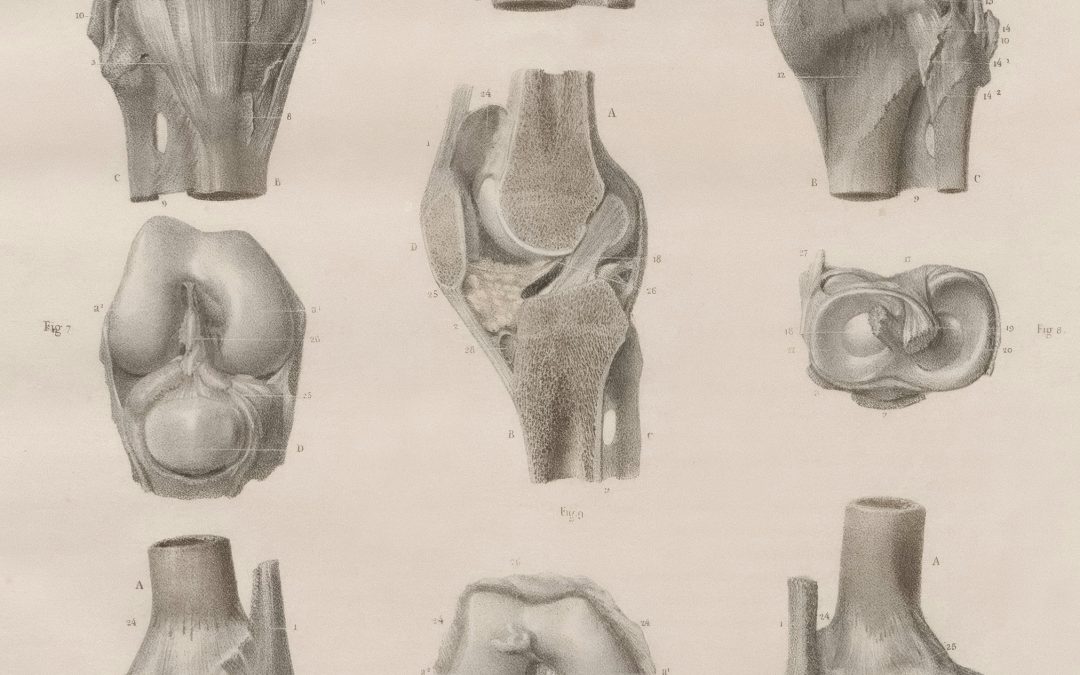Let’s face it – your knees have been putting up with a lot. They’ve carried you through childhood games of tag, teenage attempts at skateboarding (we won’t mention it too much), countless flights of stairs, and that phase where you thought you could be a weekend warrior without consequences. It’s time we gave these hardworking joints the appreciation they deserve.
The Marvel of Engineering That Are Your Knees
Your knee isn’t just a simple hinge – it’s actually one of the most complex joints in your body. Think of it as the smartphone of joints – versatile, essential and surprisingly intricate.
The knee joint primarily consists of three bones: the femur (thighbone), tibia (shinbone) and the patella (kneecap). These bones are cushioned by two C-shaped pieces of cartilage called menisci, which act like shock absorbers. Four major ligaments hold everything together: the ACL and PCL (which prevent front-to-back sliding) and the MCL and LCL (which prevent side-to-side wobbling). Meanwhile, the quadriceps and hamstring muscles provide the power and stability to keep you moving.
Research shows that during normal walking, your knees experience forces equivalent to 2-3 times your body weight, and this can increase to 7-10 times your body weight during activities like jumping or running downhill. That’s a lot of pressure for something roughly the size of a small grapefruit.
When Knees Cry for Help: Common Injuries
Even the best-engineered systems can run into trouble, and knees are no exception. Here are the usual suspects:
Runner’s Knee (Patellofemoral Pain Syndrome): Despite its name, you don’t have to be a runner to get this one. It’s the overachiever of knee problems, accounting for about 25% of all knee injuries seen in sports medicine clinics. The pain typically occurs around or behind the kneecap and feels worse when climbing stairs or sitting for long periods.
ACL Tears: The anterior cruciate ligament tear is the dramatic injury that makes athletes crumple to the ground. Women are 2-8 times more likely to experience ACL injuries than men, particularly in sports involving cutting and pivoting movements.
Meniscus Tears: These cartilage tears can happen from a single traumatic event or gradual wear and tear. Fun fact: after age 40, you’re more likely to tear your meniscus from simply getting out of bed the wrong way than from any athletic heroics.
IT Band Syndrome: The iliotibial band runs along the outside of your thigh and can become tight and irritated, causing pain on the outer side of the knee. It’s particularly common in runners and cyclists who suddenly increase their training intensity.
The Prevention Prescription: Keeping Your Knees Happy
The good news? Many knee problems are preventable with the right approach. Here’s your evidence-based action plan:
Strengthen the Supporting Cast
Your knees rely heavily on the muscles around them for stability. Research consistently shows that strengthening your quadriceps, hamstrings, and hip muscles can significantly reduce knee injury risk. Focus on exercises like squats, lunges, and hip strengthening exercises. Your physiotherapist can design a program that is right for your specific needs.
Don’t Skip the Warm-Up
A proper warm-up increases blood flow to your muscles and joints, making them more pliable and less injury prone. Studies show that structured warm-up programs can reduce knee injury rates by up to 50% in athletes.
Master the Art of Movement
How you move matters just as much as how strong you are. Learning proper landing techniques, cutting mechanics and general movement patterns can dramatically reduce your injury risk. This is where working with a physiotherapist really pays dividends.
Listen to the Whispers Before They Become Screams
Pain is your body’s way of saying “Hey, something’s not right here!” Ignoring minor knee discomfort often leads to major problems down the road. Early intervention is almost always more effective and less expensive than waiting until you can barely walk.
The Weight of the Matter
Here’s a sobering statistic: for every pound of body weight you carry, your knees experience an additional 4 pounds of pressure during activities like stair climbing. This means that losing even 10 pounds can reduce the force on your knee by 40 pounds with each step up the stairs. We’re not saying you need to become a marathon runner overnight, but maintaining a healthy weight is one of the best investments you can make in your knee health.
When to Call in the Professionals
You should consider seeing a physiotherapist if you experience:
- Knee pain that persists for more than a few days
- Swelling that doesn’t respond to rest and ice
- Instability of a feeling that your knee might “give out”
- Difficulty bearing weight on the affected leg
- Significant stiffness that limits your range of motion
Remember, physiotherapists are movement experts. We don’t just treat injuries – we help prevent them from happening in the first place.
The Bottom Line
Your knees have been your faithful companions through life’s journey, and they deserve some TLC. With proper care, strengthening, and attention to movement quality, most people can keep their knees healthy and functional well into their golden years.
Think of knee health as a long-term investment rather than a quick fix. The exercises you do today, the movement patterns you practice, and the attention you pay to minor aches and pains will pay dividends for decades to come.
At our clinic, we’re passionate about helping people understand their bodies and move better. Whether you’re dealing with current knee pain or want to prevent future problems, we’re here to help you stay active and pain-free.
References:
Fukuda, T. Y., et al. (2010). Hip posterolateral musculature strengthening in sedentary women with patellofemoral pain syndrome: a randomized controlled clinical trial with 1-year follow-up. Journal of Orthopaedic & Sports Physical Therapy, 40(11), 736-746.
Kutzner, I., et al. (2010). Loading of the knee joint during activities of daily living measured in vivo in five subjects. Journal of Biomechanics, 43(11), 2164-2173.
Longo, U. G., et al. (2012). The effectiveness of injury prevention programs to modify risk factors for non-contact anterior cruciate ligament and ankle injuries in team sports: a systematic review. British Journal of Sports Medicine, 46(6), 398-412.
Messier, S. P., et al. (2005). Weight loss reduces knee-joint loads in overweight and obese older adults with knee osteoarthritis. Arthritis & Rheumatism, 52(7), 2026-2032.
Prodromos, C. C., et al. (2007). A meta-analysis of the incidence of anterior cruciate ligament tears as a function of gender, sport, and a knee injury–reduction regimen. Arthroscopy, 23(12), 1320-1325.
Taunton, J. E., et al. (2002). A retrospective case-control analysis of 2002 running injuries. British Journal of Sports Medicine, 36(2), 95-101.

